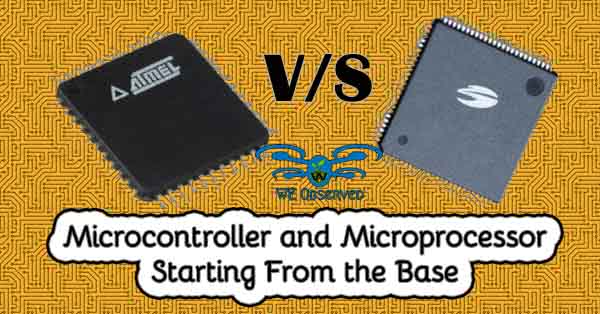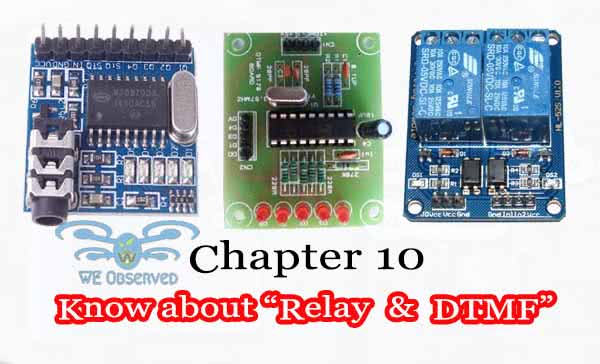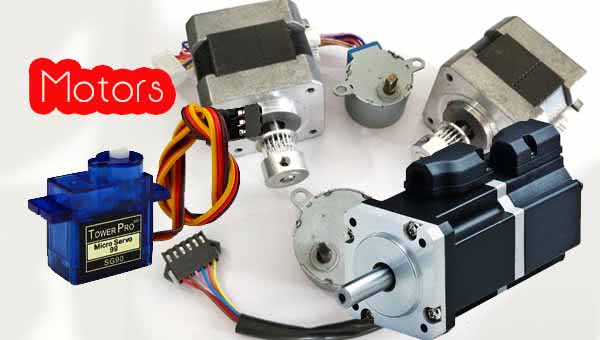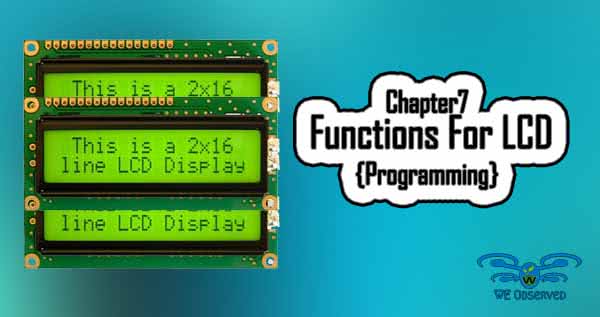Hi Everyone! The previous article was Introduction of Robotics, Where we basically just talked about what is robotics and some of the important things which need to be known before diving into the deep sea of this field. Now in this Article, we will talk about Microcontroller and Microprocessor. This is the Second chapter because without them Robotics is lifeless.
We will Connect all these chapters into a final Article soon. so Maybe all are looking separate now, but later you will understand what we were trying to prepare.

Microcontroller and Microprocessor
Microcontroller and Microprocessor are different from each other and below we are providing proper definition of each. So read it carefully and go through the complete article.
Microprocessor: A microprocessor also called as a logic chip, is a computer processor on a microchip. The microprocessor contains “Central Processing Unit” (CPU) functions and is the “engine” that goes into motion when you turn your computer on.
A microprocessor is designed to perform arithmetic and logic operations that make use of small number-holding areas called registers. The typical microprocessor includes adding, subtracting, comparing two numbers, and fetching numbers from one area to another. These operations are the result of a set of instruction that are part of the microprocessor design.
Microcontroller: A microcontroller is an Integrated circuit which is designed for a specific operation in an embedded system. A basic microcontroller consists of a processor, memory and input/ output peripherals. The microcontroller is also called an embedded controller and is found in vehicles, robots, office machines, mobile radio transceiver, vending machines as well as home appliances also.
The term Micro stands for “Small Thing” or in the power of 10-6
There is the various variety of bit in microcontroller i.e. 4-bit, 8-bit,16-bit, 32-bit, 64-bit processor. The memory which is contained by the microcontroller is RAM, Flash memory, EPROM or EEPROM. The microcontroller architecture is based on Harvard architecture or von Neumann architecture. The theory of both architectures is different.
For Harvard Architecture, the data bus and instruction are separate, allowing for simultaneous transfer while for Von Neumann architecture, one bus is used for both data and instruction. The microcontroller can be Complex instruction set computing (CISC) or Reduced Instruction Set Computing (RISC).
Also Check: What Is XAPK and How To Install XAPK on Android
Chapter 1: Introduction of Robotics, Law, History & Embedded System
General Characteristics of a Microcontroller
- The microcontroller is embedded (fix inside the circuits) so that they can control the features or actions of the products. Another name for this microcontroller is, therefore, is “embedded controller”.
- Microcontroller are dedicated to one task and run one specific program.
- Microcontrollers are often low-power devices.
- A microcontroller has a dedicated input device and often has a small LED and LCD display for output.
Difference Between Microcontroller and Microprocessor
Sometimes only Written information is not enough that’s why we are including a video here. The Video “Microcontroller and Microprocessor” is uploaded by Learning Engineering So All Credit goes to them. Watch the video and then read all the written information and you will understand the difference very easily.
Diffrence between Microcontroller and Microprocessor
| Microprocessor | Microcontroller |
|---|---|
| In this the device which is supported are external | In this the device which is supported are internal |
| MPU= CU+ ALU+ Registers | MCU=MPU/ CPU+ Peripherals+ Memory (* Memory= EEPROM, SRAM, EPROM, Flash *Peripherals= Ports, clock, timers, communication portal, ADC etc |
| In this software, protection doesn’t exist | Software protection is possible by adding lock bits at on-chip memory |
| Memory added externally | Memory is inbuilt |
Types Of Microcontroller
The microcontroller is divided on the basis of:
- Interfacing
- Family
- Memory architecture
- Instruction set
On The Basis Of Interfacing
On the basis of interfacing, there are two types i.e. Embedded and external. As the name suggests, embedded microcontrollers would be inbuilt and will not be much visible sometimes and cannot be extracted from the device.
On The Basis Of Family
From 2008, there are several dozen microcontroller architectures and vendors including:
- ARM core processors include ARM9, ARM Cortex-A8, Sitara ARM Microprocessor.
- Atmel AVR (8 bit), AVR32 (32 bit) and AT91SAM (32-bit).
- Intel 8051
- Infineon:8,16, 32 bit microcontroller
- Parallax Propeller
- Texas instrument TI MSP430 (16-bit)
- Cypress Semiconductor’s M8C core used in their PSoC (Programmable System-on-chip)
- Toshiba TLCS-870 (8-bit/16-bit)
- Rabit 2000 (8-bit)
- Microchip Technology PIC, (8-bit PIC,16-bit dsPIC33/ PIC24, (32-bit PIC32)
On the Basis of Memory Architecture
On the basis of architecture there are two types:
- Von Neumann Architecture
- Harvard Architecture
Von Neumann Architecture: It is also known as the Von Neumann model and Princeton architecture, is a computer architecture which describes a design architecture for an electronic digital computer with parts consists of a processing unit containing an arithmetic logic unit and processor registers, a control unit containing an instruction register and program counter.
Harvard Architecture: It is a computer architecture with physically separate storage and signal pathways for instructions and data. The term “Harvard Architecture” derived from the Harvard Mark I relay-based PC, which stores the information in electromechanical counters.
Based On Instruction Sets
- Reduced Instruction Set Computing (RISC)
- Complex Instruction Set Computing (CISC)
| RISC | CISC |
|---|---|
| In this small number of instruction is available | In this large number of instruction are available |
| Addressing Modes: Less | Larger |
| Memory: Save memory in term of instruction | Larger in number |
| RISC families include DEC Alpha, AMD 29k, ARC, ARM, Atmel, AVR, Blackfin, Intel i860 and i960, MIPS, Motorola 8800 | System/ 360 through z/Architecture, PDP-11, VAX, Motorola 68k and x86 |
Also Check: How To Fix File is too Large for Destination File System, All Methods
How to Remove GRUB Permanently from a Computer
Previous one and this part are the basic introductions for starting the Robotics part. In the next, we will deal with the AVR, Ports, Timer, and counters. So Just Wait and Watch what really We Observed and What we are building here. Thank you and Keep Visiting.
Article Written by Arpit Gupta and Edited by Sourabh Kumar.






